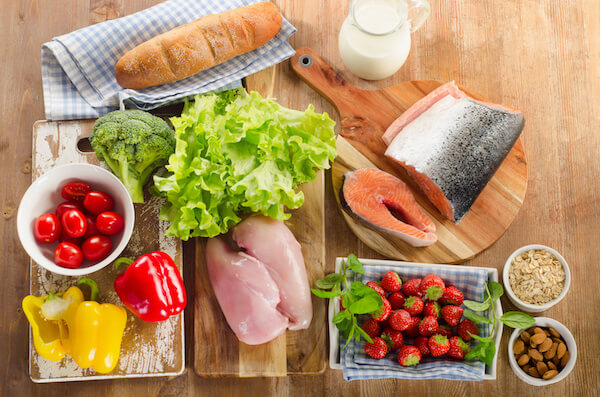Healthy Summer Eating Tips and Goals
For most people, summer is just around the corner. Living in Florida means that summer is more of a year-round term. This doesn’t mean you shouldn’t start eating healthy with a fit “summer bod” in mind, however. It’s easier than you’d think to start eating healthier, and taking small steps each week to improve your nutrition and move toward a healthier, happier you isn’t something to put off.
Here are eight healthy eating goals as suggested from the President’s Council on Fitness, Sports, and Nutrition:
Make Half of Your Plate Fruits and Veggies:
Choose red, orange, and dark green vegetables like tomatoes, sweet potatoes, and broccoli, along with other vegetables for your meals. Add fruit to meals as part of the main or side dishes, or as dessert. The more colorful you make your plate, the more likely you are to get the vitamins, minerals, and fiber your body needs to be healthy.
Make Half the Grains You Eat Whole Grains:
An easy way to eat some whole grains is to switch from a refined-grain food to a whole-grain food. For example, eat whole-wheat bread instead of white bread. Read the ingredients list and choose products that list whole-grain ingredients first. Look for things like: “whole wheat,” “brown rice,” “bulgur,” “buckwheat,” “oatmeal,” “rolled oats,” “quinoa,” or “wild rice.”
Switch to Fat-Free or Low Fat (1%) Milk:
Both have the same amount of calcium and other essential nutrients as whole milk, but fewer calories and less saturated fat.
Choose a Variety of Lean Protein Foods:
Meat, poultry, seafood, dry beans or peas, eggs, nuts, and seeds are considered part of the protein foods group. Select leaner cuts of ground beef (where the label says 90% lean or higher), turkey breast, or chicken breast.
Compare Sodium in Foods:
Use the Nutrition Facts label to choose lower sodium versions of foods like soup, bread, and frozen meals. Select canned foods that are labeled “low sodium,” “reduced sodium,” or “no salt added.”
Drink Water Instead of Sugary Drinks:
Cut calories by drinking water or unsweetened beverages. Soda, energy drinks, and sports drinks are a major source of added sugar and calories in American diets. Try adding a slice of lemon, lime, watermelon, or a splash of juice to your glass of water if you want some flavor.
Eat Some Seafood:
Seafood includes fish (such as salmon, tuna, and trout) and shellfish (such as crab, mussels, and oysters). Seafood has protein, minerals, and omega-3 fatty acids (heart-healthy fat). Adults should try to eat at least eight ounces a week of a variety of seafood. Children can eat smaller amounts of seafood, as well.
Cut Back on Solid Fats:
Eat fewer foods that contain solid fats. The major sources for Americans are cakes, cookies, and other desserts (often made with butter, margarine, or shortening); pizza; processed and fatty meats (e.g. sausages, hot dogs, bacon, ribs); and ice cream.
Here Are Some Great Tips for Emphasizing Fruits and Veggies:
- Mix vegetables into your go-to dishes. Try spinach with pasta or peppers in tacos.
- Use fresh, frozen, and canned fruits and vegetables. They all offer the same great nutrients. Just be sure to watch the sodium in canned vegetables, and look for fruits packed in water or 100% juice (not syrup).
- Pack your child’s lunch bag with fruits and vegetables: sliced apples, a banana, or carrot sticks are all healthy options.
Healthy Snacks:
- For a handy snack, keep cut-up fruits and vegetables, like carrots, peppers, or orange slices in the refrigerator.
- Teach children the difference between everyday snacks, such as fruits and vegetables, and occasional snacks, such as cookies or other sweets.
- Make water a staple of snack time. Try adding a slice of lemon, lime, or a splash of 100% juice to your water for a little flavor.
- Swap out your cookie jar for a basket filled with fresh fruit.
Reduce Fat, Salt, and Sugar:
- Choose baked or grilled food instead of fried when you’re eating out and implement this at home, too.
- Make water and fat-free or low-fat milk your go-to drinks instead of soda or sweetened beverages.
- Serve fruits as everyday desserts, like baked apples and pears or a fruit salad.
- Read labels on packaged ingredients to find foods lower in sodium.
Controlling Portion Size:
- Use smaller plates to control portion sizes.
- Don’t clean your plate or bowl if you’re full, instead save leftovers for tomorrow’s lunch.
- Portion sizes depend on the age, gender, and activity level of the individual.
Healthy Eating In School:
- Bring healthy snacks into your child’s classroom for birthday parties and celebrations, instead of providing sugary treats.
- Pack healthy lunches for your children including whole grains, fruits and vegetables, and fat-free or low-fat dairy products.



















































































































































